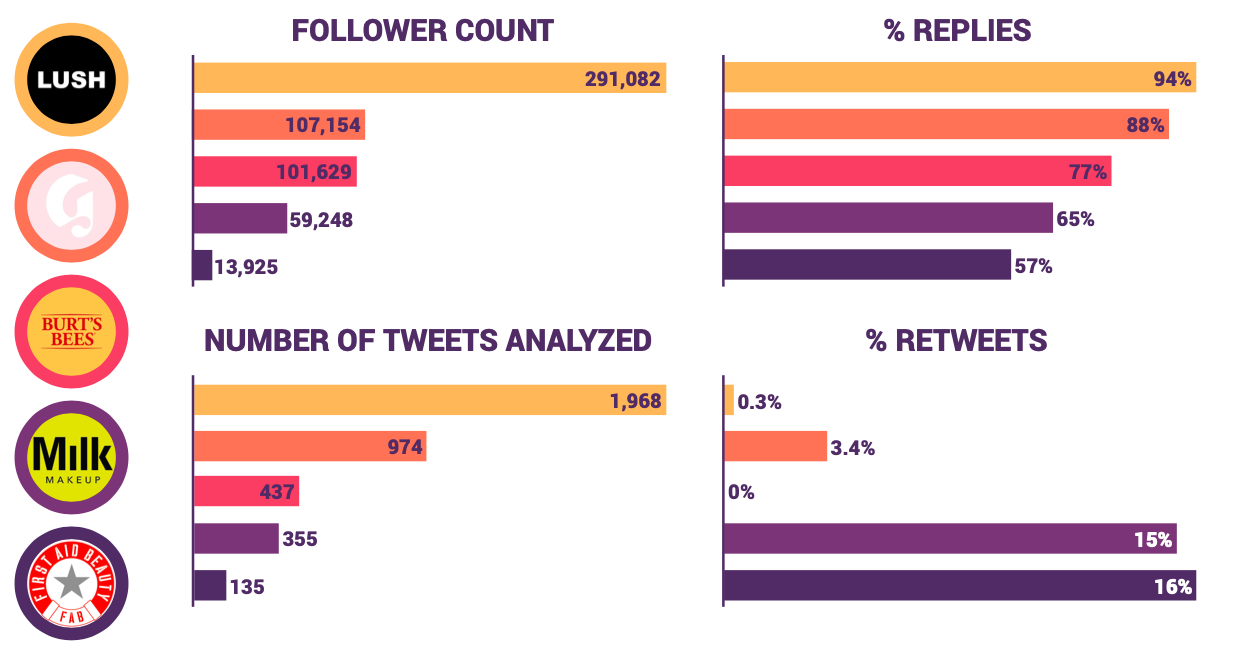Beauty Dos and Don'ts
a comparative analysis of cosmetics brands' Twitter accounts

Introduction
Social media presence has become an instrumental part of brand identity across many different industries. But from fast food companies to banks, different types of companies require different attitudes and presences while interfacing with their followers and customers. In this project, I aim to discover what makes for a successful Twitter presence in the beauty industry. I analyzed five different U.S.-based cosmetics companies with active Twitter accounts in order to draw conclusions about the ideal Twitter behaviors that suit the beauty industry's target audience.
Methodology
The five Twitter accounts I chose for this project vary in terms of follower count, volume of Tweets, and typical engagement (i.e. likes, retweets, and replies). I chose to study Lush, Glossier, Burt's Bees, Milk Makeup, and First Aid Beauty.

-
Data Gathering Data was gathered over a six-month time period, from January 1, 2020 to June 30, 2020. SuperMetrics was used to extract data from Twitter on each of the five accounts, including follower count, number of Tweets, and number of likes and retweets per Tweet.
-
Data Analysis Initial analysis was performed in Google Sheets, mainly because SuperMetrics directly exported data into a Google Sheets document. Tweets were classified into one of four categories: original Tweets, retweets, quote-retweets, and replies. For each Tweet, information such as engagement, presence of photos or videos, and links to external content were noted.
In addition to analyzing the overall trends in Tweets, some of the most successful and least successful individual Tweets were examined to discover any similarities between them.
-
Data Visualization Once the data was examined, it was loaded into Tableau for initial visualizations. Because the final deliverable for this project was a presentation, I then used Adobe InDesign to enhance the appearance of the visualizations, as well as to create presentation slides.
The data used for this project, in spreadsheet format (.xlsx), is available for download here.
Findings
Highlighted findings include:
-
Account Statistics There was a very solid correlation between accounts with more followers and other behaviors. Within the period analyzed, accounts with more followers posted more Tweets, replied more to Tweets, and did not retweet as many Tweets without adding a quote comment. (Replies and retweets were analyzed as percentages in order to normalize for the large differences in Tweet volume between accounts.)

-
Tweet Timing Most Tweets were posted within a window that might correspond to "business hours" in the U.S. — about 9am to 6pm. This was consistent across accounts.

-
Tweet Engagement Engagement on Tweets was represented by a simple formula: interaction rate = (likes + retweets)/followers. This revealed a similar time-frame of activity: most interaction occured between 10am and 12pm, or between 3pm and 7pm.

Conclusions
Through the above data analysis, as well as analysis of individual Tweets, a number of key behaviors were identified as being successful for gaining followers and maintaining regular engagement.
-
Schedule Accounts should aim to post a Tweet at least once a day, ideally between the hours of 10am and 7pm.
-
Content Emojis, photos, and video content all help to catch the eye of the audience, and lead to higher engagement. Using key words and hashtags is also a good way to increase engagement, by capitalizing on current trends. These trends can also be used to promote less engaging content, especially external links.
-
Interactions While replying to users' complaints, questions, and compliments doesn't lead to a direct gain in engagement, it's an important aspect of customer care and is practiced by the highest-follower accounts in this analysis. Quote-retweeting positive brand mentions, or popular Twitter accounts, is more successful than retweeting without a comment.
-
Brand Identity Beauty brands can be expected to have a playful, modern tone and vocabulary in their Tweets. In addition, posting about political topics can keep audiences aware of any social responsibility initiatives, and help people feel they are supporting ethical brands.
Future work in this vein might analyze other corporate accounts from elsewhere in the world or from different industries, in order to determine which strategies might work for any brand and which should be tailored by target audience.
The final deliverable for this project, in the form of a presentation slide deck, can be downloaded here.
References
Sehl, K. "6 Ways to Calculate Engagement Rate on Social Media." Retrieved from https://blog.hootsuite.com/calculate-engagement-rate/.
SuperMetrics. "SuperMetrics for Google Sheets." Retrieved from https://supermetrics.com/docs/product-google-sheets-getting-started/.
Twitter. "Burt's Bees." Retrieved from https://twitter.com/burtsbees.
Twitter. "First Aid Beauty®." Retrieved from https://twitter.com/firstaidbeauty.
Twitter. "Glossier." Retrieved from https://twitter.com/glossier.
Twitter. "Lush North America." Retrieved from https://twitter.com/lushcosmetics.
Twitter. "Milk Makeup." Retrieved from https://twitter.com/milkmakeup.